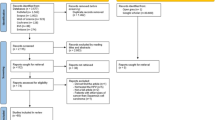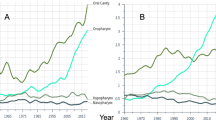Abstract
This study examines trends in age-adjusted incidence rates of human papillomavirus (HPV)-related oropharyngeal squamous cell carcinoma (OPSCC) in comparison to oral cavity proper squamous cell carcinoma (OSCC) in the population of Vermont from 1999 to 2013. Data on cases of oral and pharynx cancers diagnosed in Vermont between 1999 and 2013 were obtained from the Vermont cancer registry. The age-adjusted incidence rates and annual percentage change of HPV-related OPSCC and OSCC were calculated using Joinpoint trend analysis. Four hundred and thirty-one cases of HPV-related OPSCC were diagnosed from 1999 to 2013. Males constituted 83% (P < 0.0001) of the cases and the 6th decade of life marked the highest incidence. The overall age-adjusted incidence rates for HPV-related OPSCC significantly increased (from 2.39 to 3.86 per 100,000, P < 0.0001). In males, it significantly increased (from 3.62 to 6.93 per 100,000, P < 0.0001), while in females it remained stable (from 1.18 to 1.02 per 100,000, P = 0.28) during 1999–2013. The average rate of HPV-related OPSCC significantly increased by 4.4% annually (P = 0.004). In males the average rate significantly increased by 5.3% annually (P = 0.001) and in females the rate increased by 0.37% annually (P = 0.87). In contrast, age-adjusted overall incidence rates for OSCC significantly decreased (from 3.99 to 3.35 per 100,000, P = 0.018). The overall rate of OSCC decreased by 0.96% annually (P = 0.37) and the highest incidence of cases was in the 7th decade of life. In conclusion, there was an increasing trend of HPV-related OPSCC, specifically in males, and there appears to be a decreasing trend of OSCC in Vermont.




Similar content being viewed by others
References
Al-Mamgani, A., van Rooij, P., Tans, L., Verduijn, G. M., Sewnaik, A., & Baatenburg de Jong, R. J. (2013). A prospective evaluation of patient-reported quality-of-life after (chemo)radiation for oropharyngeal cancer: Which patients are at risk of significant quality-of-life deterioration? Radiotherapy and Oncology, 106(3), 359–363. https://doi.org/10.1016/j.radonc.2012.12.014.
Ang, K. K., Harris, J., Wheeler, R., Weber, R., Rosenthal, D. I., Nguyen-Tan, P. F., Westra, W. H., et al. (2010). Human papillomavirus and survival of patients with oropharyngeal cancer. New England Journal of Medicine, 363(1), 24–35. https://doi.org/10.1056/NEJMoa0912217.
Bernard, H. U., Burk, R. D., Chen, Z., van Doorslaer, K., zur Hausen, H., & de Villiers, E. M. (2010). Classification of papillomaviruses (PVs) based on 189 PV types and proposal of taxonomic amendments. Virology, 401(1), 70–79. https://doi.org/10.1016/j.virol.2010.02.002.
Carvalho, A. L., Nishimoto, I. N., Califano, J. A., & Kowalski, L. P. (2005). Trends in incidence and prognosis for head and neck cancer in the United States: A site-specific analysis of the SEER database. International Journal of Cancer, 114(5), 806–816. https://doi.org/10.1002/ijc.20740.
Chaturvedi, A. K., Engels, E. A., Anderson, W. F., & Gillison, M. L. (2008). Incidence trends for human papillomavirus-related and -unrelated oral squamous cell carcinomas in the United States. Journal of Clinical Oncology, 26(4), 612–619. https://doi.org/10.1200/JCO.2007.14.1713.
Chaturvedi, A. K., Engels, E. A., Pfeiffer, R. M., Hernandez, B. Y., Xiao, W., Kim, E., Jiang, B., et al. (2011). Human papillomavirus and rising oropharyngeal cancer incidence in the United States. Journal of Clinical Oncology, 29(32), 4294–4301. https://doi.org/10.1200/JCO.2011.36.4596.
D’Souza, G., Kreimer, A. R., Viscidi, R., Pawlita, M., Fakhry, C., Koch, W. M., Westra, W. H., & Gillison, M. L. (2007). Case-control study of human papillomavirus and oropharyngeal cancer. New England Journal of Medicine, 356(19), 1944–1956. https://doi.org/10.1056/NEJMoa065497.
de Villiers, E. M. (2013). Cross-roads in the classification of papillomaviruses. Virology, 445(1–2), 2–10. https://doi.org/10.1016/j.virol.2013.04.023.
Fakhry, C., Westra, W. H., Li, S., Cmelak, A., Ridge, J. A., Pinto, H., Forastiere, A., & Gillison, M. L. (2008). Improved survival of patients with human papillomavirus-positive head and neck squamous cell carcinoma in a prospective clinical trial. Journal of the National Cancer Institute, 100(4), 261–269. https://doi.org/10.1093/jnci/djn011.
Fuller, K. M., & Hinyard, L. (2017). Factors associated with HPV vaccination in young males. Journal of Community Health, 42(6), 1127–1132. https://doi.org/10.1007/s10900-017-0361-4.
Gillison, M. L., Koch, W. M., Capone, R. B., Spafford, M., Westra, W. H., Wu, L., Zahurak, M. L., et al. (2000). Evidence for a causal association between human papillomavirus and a subset of head and neck cancers. Journal of the National Cancer Institute, 92(9), 709–720.
Hunter, K. U., Schipper, M., Feng, F. Y., Lyden, T., Haxer, M., Murdoch-Kinch, C. A., Cornwall, B., Lee, C. S., Chepeha, D. B., & Eisbruch, A. (2013). Toxicities affecting quality of life after chemo-IMRT of oropharyngeal cancer: Prospective study of patient-reported, observer-rated, and objective outcomes. International Journal of Radiation Oncology Biology Physics, 85(4), 935–940. https://doi.org/10.1016/j.ijrobp.2012.08.030.
Lewis, J. S. Jr., Beadle, B., Bishop, J. A., Chernock, R. D., Colasacco, C., Lacchetti, C., Moncur, J. T., et al. (2017). Human papillomavirus testing in head and neck carcinomas: Guideline from the College of American Pathologists. Archives of Pathology & Laboratory Medicine. https://doi.org/10.5858/arpa.2017-0286-CP.
Lindquist, D., Romanitan, M., Hammarstedt, L., Nasman, A., Dahlstrand, H., Lindholm, J., Onelov, L., et al. (2007). Human papillomavirus is a favourable prognostic factor in tonsillar cancer and its oncogenic role is supported by the expression of E6 and E7. Molecular Oncology, 1(3), 350–355. https://doi.org/10.1016/j.molonc.2007.08.005.
Marur, S., D’Souza, G., Westra, W. H., & Forastiere, A. A. (2010). HPV-associated head and neck cancer: A virus-related cancer epidemic. The Lancet Oncology, 11(8), 781–789. https://doi.org/10.1016/S1470-2045(10)70017-6.
McGuire, D. B., Fulton, J. S., Park, J., Brown, C. G., Correa, M. E., Eilers, J., Elad, S., et al. (2013). Systematic review of basic oral care for the management of oral mucositis in cancer patients. Supportive Care in Cancer, 21(11), 3165–3177. https://doi.org/10.1007/s00520-013-1942-0.
Mellin, H., Dahlgren, L., Munck-Wikland, E., Lindholm, J., Rabbani, H., Kalantari, M., & Dalianis, T. (2002). Human papillomavirus type 16 is episomal and a high viral load may be correlated to better prognosis in tonsillar cancer. International Journal of Cancer, 102(2), 152–158. https://doi.org/10.1002/ijc.10669.
Monteiro, L. S., Antunes, L., Bento, M. J., & Warnakulasuriya, S. (2013). Incidence rates and trends of lip, oral and oro-pharyngeal cancers in Portugal. Journal of Oral Pathology & Medicine, 42(4), 345–351. https://doi.org/10.1111/jop.12010.
Mourad, M., Jetmore, T., Jategaonkar, A. A., Moubayed, S., Moshier, E., & Urken, M. L. (2017). Epidemiological trends of head and neck cancer in the United States: A SEER population study. Journal of Oral and Maxillofacial Surgery, 75(12), 2562–2572. https://doi.org/10.1016/j.joms.2017.05.008.
Munger, K., Werness, B. A., Dyson, N., Phelps, W. C., Harlow, E., & Howley, P. M. (1989). Complex formation of human papillomavirus E7 proteins with the retinoblastoma tumor suppressor gene product. The EMBO Journal, 8(13), 4099–4105.
Muwonge, R., Ramadas, K., Sankila, R., Thara, S., Thomas, G., Vinoda, J., & Sankaranarayanan, R. (2008). Role of tobacco smoking, chewing and alcohol drinking in the risk of oral cancer in Trivandrum, India: A nested case-control design using incident cancer cases. Oral Oncology, 44(5), 446–454. https://doi.org/10.1016/j.oraloncology.2007.06.002.
Nasman, A., Attner, P., Hammarstedt, L., Du, J., Eriksson, M., Giraud, G., Ahrlund-Richter, S., et al. (2009). Incidence of human papillomavirus (HPV) positive tonsillar carcinoma in Stockholm, Sweden: An epidemic of viral-induced carcinoma? International Journal of Cancer, 125(2), 362–366. https://doi.org/10.1002/ijc.24339.
Owosho, A. A., Pedreira Ramalho, L. M., Rosenberg, H. I., Yom, S. K., Drill, E., Riedel, E., Tsai, C. J., Lee, N. Y., Huryn, J. M., & Estilo, C. L. (2016). Objective assessment of trismus in oral and oropharyngeal cancer patients treated with intensity-modulated radiation therapy (IMRT). Journal of Cranio-Maxillo-Facial Surgery, 44(9), 1408–1413. https://doi.org/10.1016/j.jcms.2016.06.008.
Owosho, A. A., Thor, M., Oh, J. H., Riaz, N., Tsai, C. J., Rosenberg, H., Varthis, S., et al. (2017). The role of parotid gland irradiation in the development of severe hyposalivation (xerostomia) after intensity-modulated radiation therapy for head and neck cancer: Temporal patterns, risk factors, and testing the QUANTEC guidelines. Journal of Cranio-Maxillo-Facial Surgery, 45(4), 595–600. https://doi.org/10.1016/j.jcms.2017.01.020.
Owosho, A. A., Tsai, C. J., Lee, R. S., Freymiller, H., Kadempour, A., Varthis, S., Sax, A. Z., et al. (2017). The prevalence and risk factors associated with osteoradionecrosis of the jaw in oral and oropharyngeal cancer patients treated with intensity-modulated radiation therapy (IMRT): The Memorial Sloan Kettering Cancer Center experience. Oral Oncology, 64, 44–51. https://doi.org/10.1016/j.oraloncology.2016.11.015.
Paz, I. B., Cook, N., Odom-Maryon, T., Xie, Y., & Wilczynski, S. P. (1997). Human papillomavirus (HPV) in head and neck cancer. An association of HPV 16 with squamous cell carcinoma of Waldeyer’s tonsillar ring. Cancer, 79(3), 595–604.
Ragin, C. C., & Taioli, E. (2007). Survival of squamous cell carcinoma of the head and neck in relation to human papillomavirus infection: Review and meta-analysis. International Journal of Cancer, 121(8), 1813–1820. https://doi.org/10.1002/ijc.22851.
Reagan-Steiner, S., Yankey, D., Jeyarajah, J., Elam-Evans, L. D., Curtis, C. R., MacNeil, J., Markowitz, L. E., & Singleton, J. A. (2016). National, regional, state, and selected local area vaccination coverage among adolescents Aged 13–17 years—United States, 2015. MMWR Morbidity and Mortality Weekly Report, 65(33), 850–858. https://doi.org/10.15585/mmwr.mm6533a4.
Scheffner, M., Werness, B. A., Huibregtse, J. M., Levine, A. J., & Howley, P. M. (1990). The E6 oncoprotein encoded by human papillomavirus types 16 and 18 promotes the degradation of p53. Cell, 63(6), 1129–1136.
Shin, A., Jung, Y. S., Jung, K. W., Kim, K., Ryu, J., & Won, Y. J. (2013). Trends of human papillomavirus-related head and neck cancers in Korea: National cancer registry data. The Laryngoscope, 123(11), E30–E37. https://doi.org/10.1002/lary.24243.
Steinau, M., Saraiya, M., Goodman, M. T., Peters, E. S., Watson, M., Cleveland, J. L., Lynch, C. F., et al. (2014). Human papillomavirus prevalence in oropharyngeal cancer before vaccine introduction, United States. Emerging Infectious Diseases, 20(5), 822–828. https://doi.org/10.3201/eid2005.131311.
Underwood, J. M., Richards, T. B., Henley, S. J., Momin, B., Houston, K., Rolle, I., Holmes, C., & Stewart, S. L. (2015). Decreasing trend in tobacco-related cancer incidence, United States 2005–2009. Journal of Community Health, 40(3), 414–418. https://doi.org/10.1007/s10900-014-9951-6.
Viens, L. J., Henley, S. J., Watson, M., Markowitz, L. E., Thomas, C. C., Thompson, T. D., Razzaghi, H., & Saraiya, M. (2016). Human papillomavirus-associated cancers—United States, 2008–2012. MMWR Morbidity and Mortality Weekly Report, 65(26), 661–666. https://doi.org/10.15585/mmwr.mm6526a1.
Werness, B. A., Levine, A. J., & Howley, P. M. (1990). Association of human papillomavirus types 16 and 18 E6 proteins with p53. Science, 248(4951), 76–79.
Acknowledgements
We would like to thank Ali Johnson, MBA, CTR of the Vermont Cancer Registry for helping us with the data acquisition. These findings are solely the responsibility of the authors and do not necessarily represent the official views of the Centers for Disease Control & Prevention or Vermont Department of Health and Human Services.
Author information
Authors and Affiliations
Corresponding author
Ethics declarations
Conflict of interest
All authors declare that there are no financial conflicts associated with this study.
Rights and permissions
About this article
Cite this article
Owosho, A.A., Wiley, R., Stansbury, T. et al. Trends in Human Papillomavirus-Related Oropharyngeal Squamous Cell Carcinoma Incidence, Vermont 1999–2013. J Community Health 43, 731–737 (2018). https://doi.org/10.1007/s10900-018-0477-1
Published:
Issue Date:
DOI: https://doi.org/10.1007/s10900-018-0477-1




